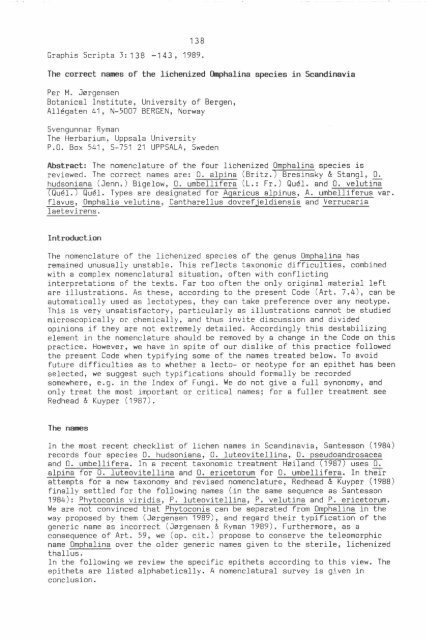-ry wL - Universitetet i Oslo
-ry wL - Universitetet i Oslo
-ry wL - Universitetet i Oslo
You also want an ePaper? Increase the reach of your titles
YUMPU automatically turns print PDFs into web optimized ePapers that Google loves.
138<br />
Graphis Scripta l:138 -143, 1989.<br />
The comeet nares of the liehenized tlnphalina species in Seandinavia<br />
Per M, Jorgensen<br />
Botanical Institute, University of Bergen,<br />
AIldgaten 41, N-5007 BERGEN, Norway<br />
Svengunnar Ryman<br />
The Herbarium, Uppsala University<br />
P.0. Box 5tt1 , 5-751 21 UPPSALA, Sweden<br />
Abstraet: The nomenclature of the four lichenized 0mphalina species is<br />
reviewed.ThecorrectnameSare30'g\r-iqa(gritz.ffiky&Stang1'0.<br />
hudsoniana(Jenn.)Bige1ow,0.um6ffi(L.:Fr')Qu61.and0.veIutii?<br />
TQ..riTr6l. Types "re oesi. , A. umbffir.<br />
fLavus, Omphalia velutina, Cantharellus dovrefjeldiensis and Verrucaria<br />
laetevirens.<br />
Introduction<br />
The nomenclalure of the liehenized species of the genus Omphalina has<br />
remained unusually unstabJe. This refleets taxonomic difficulties, combined<br />
with a eomplex nomenclatural situation, often with eonfliet,ing<br />
interpretations of the texts. Far too often the only original material left<br />
are illustrations. As t.hese, according to the present Code (Rrt. 7.4), can be<br />
automatically used as lectotypes, they can take preference over any neotype.<br />
This is ve<strong>ry</strong> unsatisfacto<strong>ry</strong>, particularly as illustrations eannot be studied<br />
microscopically or chemically, and thus invite diseussion and divided<br />
opinions if they are not extremely detailed. Accordingly this destabilizing<br />
element in the nomenclature should be removed by a change in the Code on this<br />
practiee. Howeverr wE have in spite of our dislike of this practice followed<br />
the present Code when typifying some of the names treated below. To avoid<br />
future difficulties as to whether a lecto- or neotype for an epit,het has been<br />
selected, we suggest such typifications should formally be recorded<br />
somewhere, e.g. in the Index of Fungi. }|e do not give a full synonomy, and<br />
only treat the most important or critical names; for a fuller treatment see<br />
Redhead & Kuyper (tgg7).<br />
The nEilEs<br />
In the most reeent ehecklist of liehen names in Seandinavia, Santesson (1984)<br />
records four species 0. hudsoniana, 0. luteovitellina, 0. psgudoandrosacea<br />
and o. umbellifera. Imo i<br />
and 0. ericetorulm for 0. umbellifera. In thEir<br />
Ettempts foi a-new taxon-my and revised-nomenClature, ReOneaA & Kuyper (1988)<br />
finally settled for the following names ( in the same sequence as Santesson<br />
1984)t Phytoconis viridis, P. luteovitellina-, P. velutina and P. erieetorum.<br />
We are not convinced that Phytoconis can bre separated from Omphalina in the<br />
way proposed by them (.:org6-GiliF), and regard their typification of the<br />
generic name as incorrect (Jargensen & Ryman 1989). Furthermorer BS a<br />
consequence of Art. 59 , we ( op. cit. ) propose to conserve the teleomorphic<br />
name Omphalina over the older generic names given to the sterile, liehenized<br />
thallus.<br />
In the following we review the specific epithets according to this view. The<br />
epithets are listed alphabetieally. A nomenclatural survey is g-i-ven in<br />
conclusion.

















